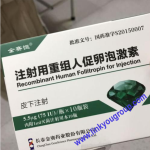- Description
- Inquiry
Description
Simple description:
Product Name: Estrone
CAS: 53-16-7
Melting point :258-260 °C(lit.)
Boiling point: 353.48°C (rough estimate)
Density 1.2360
Refractive index:165 ° (C=1, Dioxane)
Description
Estrone is one of the three naturally occurring estrogens, the others being estradiol and estriol. Estrone is synthesized from androstenedione by the aromatase enzyme system in the ovaries and placenta, and is also synthesized from estradiol by 17-hydroxy steroid dehydrogenase in the liver.Serum concentrations of estrone in premenopausal women fluctuate according to the menstrual cycle and becomes the most predominant estrogen in postmenopausal women.The binding affinities of estrone to the estrogen receptors α and β are approximately 60% and 37% relative to estradiol.
Chemical Properties
Estrone is an odorless white crystalline powder. Estrone is supplied as a crystalline solid. A stock solution may be made by dissolving the estrone in an organic solvent purged with an inert gas. Estrone is soluble in organic solvents such as DMSO and dimethyl formamide (DMF). The solubility of estrone in these solvents is approximately 20 mg/ml.
Estrone is sparingly soluble in aqueous buffers. For maximum solubility in aqueous buffers, estrone should first be dissolved in DMF and then diluted with the aqueous buffer of choice. Estrone has a solubility of approximately 0.15 mg/ml in a1:5 solution of DMF:PBS (pH 7.2) using this method. We do not recommend storing the aqueous solution for more than one day.
Uses:
It is mainly used for uterine hypoplasia, Menstrual disorder and climacteric disorders. It is an intermediate for the synthesis of Ethinylestradiol. May cause nausea, vomiting, dizziness, etc. Prolonged use can cause excessive endometrial hyperplasia and bleeding.





